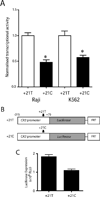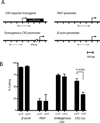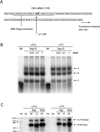Transcriptional effects of a lupus-associated polymorphism in the 5' untranslated region (UTR) of human complement receptor 2 (CR2/CD21)
- PMID: 22673213
- PMCID: PMC3401243
- DOI: 10.1016/j.molimm.2012.04.013
Transcriptional effects of a lupus-associated polymorphism in the 5' untranslated region (UTR) of human complement receptor 2 (CR2/CD21)
Abstract
Systemic lupus erythematosus (SLE) is a complex autoimmune disease with a strong genetic component that determines risk. A common three single-nucleotide polymorphism (SNP) haplotype of the complement receptor 2 (CR2) gene has been associated with increased risk of SLE (Wu et al., 2007; Douglas et al., 2009), and a less common haplotype consisting of the major allele at SNP1 and minor alleles at SNP2 and 3 confers protection (Douglas et al., 2009). SNP1 (rs3813946), which is located in the 5' untranslated region (UTR) of the CR2 gene, altered transcriptional activity of a CR2 promoter-luciferase reporter gene construct transiently transfected into a B cell line (Wu et al., 2007) and had an independent effect in the protective haplotype (Douglas et al., 2009). In this study, we show that this SNP alters transcriptional activity in a transiently transfected non B-cell line as well as in stably transfected cell lines, supporting its relevance in vivo. Furthermore, the allele at this SNP affects chromatin accessibility of the surrounding sequence and transcription factor binding. These data confirm the effects of rs3813946 on CR2 transcription, identifying the 5' UTR to be a novel regulatory element for the CR2 gene in which variation may alter gene function and modify the development of lupus.
Copyright © 2012 Elsevier Ltd. All rights reserved.
Conflict of interest statement
Conflict of interest: The authors declare no conflict of interest.
Figures






Similar articles
-
Association of Complement Receptor 2 Gene Polymorphisms with Susceptibility to Osteonecrosis of the Femoral Head in Systemic Lupus Erythematosus.Biomed Res Int. 2016;2016:9208035. doi: 10.1155/2016/9208035. Epub 2016 Jun 30. Biomed Res Int. 2016. PMID: 27446959 Free PMC article.
-
Cr2, a candidate gene in the murine Sle1c lupus susceptibility locus, encodes a dysfunctional protein.Immunity. 2001 Nov;15(5):775-85. doi: 10.1016/s1074-7613(01)00228-x. Immunity. 2001. PMID: 11728339
-
Association of a common complement receptor 2 haplotype with increased risk of systemic lupus erythematosus.Proc Natl Acad Sci U S A. 2007 Mar 6;104(10):3961-6. doi: 10.1073/pnas.0609101104. Epub 2007 Feb 22. Proc Natl Acad Sci U S A. 2007. PMID: 17360460 Free PMC article.
-
Role of complement in the development of autoimmunity.Curr Dir Autoimmun. 2003;6:154-68. doi: 10.1159/000066860. Curr Dir Autoimmun. 2003. PMID: 12408051 Review.
-
Role of complement receptor 2 in the pathogenesis of systemic lupus erythematosus.Adv Exp Med Biol. 2005;560:141-7. doi: 10.1007/0-387-24180-9_17. Adv Exp Med Biol. 2005. PMID: 15932028 Review. No abstract available.
Cited by
-
Association of Complement Receptor 2 Gene Polymorphisms with Susceptibility to Osteonecrosis of the Femoral Head in Systemic Lupus Erythematosus.Biomed Res Int. 2016;2016:9208035. doi: 10.1155/2016/9208035. Epub 2016 Jun 30. Biomed Res Int. 2016. PMID: 27446959 Free PMC article.
-
Focused transcription from the human CR2/CD21 core promoter is regulated by synergistic activity of TATA and Initiator elements in mature B cells.Cell Mol Immunol. 2016 Jan;13(1):119-31. doi: 10.1038/cmi.2014.138. Epub 2015 Feb 2. Cell Mol Immunol. 2016. PMID: 25640655 Free PMC article.
-
Molecular prioritization strategies to identify functional genetic variants in the cardiovascular disease-associated expression QTL Vanin-1.Eur J Hum Genet. 2014 May;22(5):688-95. doi: 10.1038/ejhg.2013.208. Epub 2013 Sep 18. Eur J Hum Genet. 2014. PMID: 24045843 Free PMC article.
-
Human fetal globin gene expression is regulated by LYAR.Nucleic Acids Res. 2014 Sep;42(15):9740-52. doi: 10.1093/nar/gku718. Epub 2014 Aug 4. Nucleic Acids Res. 2014. PMID: 25092918 Free PMC article.
-
Functional polymorphism in the 5'-UTR of CR2 is associated with susceptibility to nasopharyngeal carcinoma.Oncol Rep. 2013 Jul;30(1):11-6. doi: 10.3892/or.2013.2421. Epub 2013 Apr 23. Oncol Rep. 2013. PMID: 23612877 Free PMC article.
References
-
- Ahearn JM, Fischer MB, Croix D, Goerg S, Ma M, Xia J, Zhou X, Howard RG, Rothstein TL, Carroll MC. Disruption of the Cr2 locus results in a reduction in B-1a cells and in an impaired B cell response to T-dependent antigen. Immunity. 1996;4:251–262. - PubMed
-
- Boackle SA, Holers VM, Chen X, Szakonyi G, Karp DR, Wakeland EK, Morel L. Cr2, a candidate gene in the murine Sle1c lupus susceptibility locus, encodes a dysfunctional protein. Immunity. 2001;15:775–785. - PubMed
-
- Chen Y, Dong E, Grayson DR. Analysis of the GAD1 promoter: trans-acting factors and DNA methylation converge on the 5' untranslated region. Neuropharmacology. 2011;60:1075–1087. - PubMed
Publication types
MeSH terms
Substances
Grants and funding
LinkOut - more resources
Full Text Sources
Other Literature Sources
Medical

